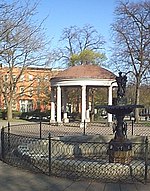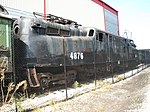H. L. Mencken House
The H. L. Mencken House was the home of Baltimore Sun journalist and author Henry Louis Mencken, who lived here from 1883 until his death in 1956. The Italianate brick row house at 1524 Hollins Street in Baltimore was designated a National Historic Landmark in 1985. Mencken wrote of his home: "I have lived in one house in Baltimore for nearly 45 years. It has changed in that time, as I have—but somehow it still remains the same.... It is as much a part of me as my two hands. If I had to leave it I'd be as certainly crippled as if I lost a leg."After his death on January 26, 1956, his home was bequeathed to the University of Maryland. In 1983 the City of Baltimore acquired the H. L. Mencken House from the university, in exchange for the Old Pine Street Station. With period furniture, his restored second-floor office, and backyard gazebo, the H. L. Mencken House opened as part of the City Life Museums and a center for theatrical, literary and musical events. Although the City Life Museums closed in 1997, the landmark still displays a special commemorative plaque about its famous occupant. The organization "Friends of the H. L. Mencken House" led efforts of several groups to redirect and expand the use of it. A $3 million donation from retired naval commander Max Hency in 2018 allowed the organization to begin renovating the house, and it opened to the public in 2019, though only by prior reservation.It was declared a National Historic Landmark in 1983.
Excerpt from the Wikipedia article H. L. Mencken House (License: CC BY-SA 3.0, Authors).H. L. Mencken House
Hollins Street, Baltimore Sowebo
Geographical coordinates (GPS) Address External links Nearby Places Show on map
Geographical coordinates (GPS)
| Latitude | Longitude |
|---|---|
| N 39.287555555556 ° | E -76.641833333333 ° |
Address
H.L. Mencken House
Hollins Street 1524
21223 Baltimore, Sowebo
Maryland, United States
Open on Google Maps








